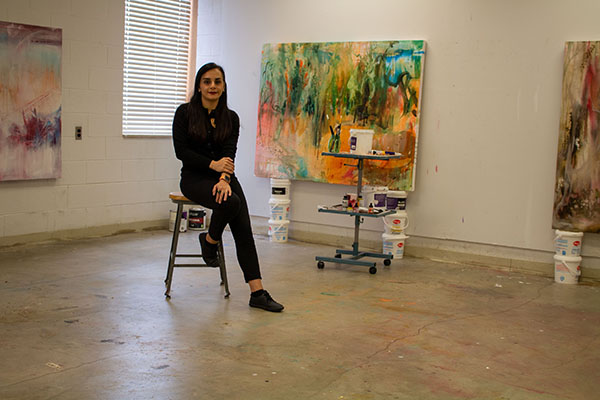By REBECCA WAGNER, Student Reporter

Saba Farhoudnia never really cared for toys when she was a child. She had the desire to draw instead.
Farhoudnia had such an attachment to her art supplies that she would find herself even sleeping with the pens and pencils.
That attachment has grown into a love that allows her to use it in her life and helps to continue her painting practice today.
“I have a lot of ideas,” Farhoudnia said. “Sometimes my ideas are out of my control. Drawing is my way of calming my mind and organizing my thoughts.”
Drawing in her sketchbooks helps Farhoudnia gather ideas for her paintings, she said, and calms her down.
Farhoudnia has spent the month of April as the NWOSU artist-in-resident.
She will hold an art show at the end of her stay to share the different pieces that she has had the opportunity to create while she is at Northwestern. Recently, she also gave an artist talk and conducted a workshop with students.
Farhoudnia was born in Iran. She studied art there and moved to the United States in 2013. She currently lives in New York.
Farhoudnia continued her education in the United States in 2017. She explained that art is taught differently in Western and Eastern art universities.
“Western universities focus more on multidisciplinary and experimental work,” she said.
Having feedback from visiting artist critiques and studio visits from other painters encouraged Farhoudnia to apply to MFA programs.
She graduated from LeRoy E. Hoffberger School of Painting at Maryland Institute College of Art in Baltimore.
During her time in MICA’s MFA program, Farhoudnia developed her own painting language.
When her father passed away, she said she experienced mourning for the first time. She said she handled the pain of loss by painting in her studio, pouring all the pain into a piece called “Ruby Moss from the Cosmos.” It is her favorite, she said, and she will never part with it.
Farhoudnia said she felt, as if for the first time, that she was living inside of her own painting.
The narratives in Farhoudnia’s paintings are always a little different. She creates works that are brightly colored and seen as welcoming. The pieces she creates evoke various kinds of emotions for the viewer, she pointed out.
“They’re not joyful moments that I’m presenting,” she said. “It’s a battlefield … figures trying to survive within and from their environment, something very dark.”
